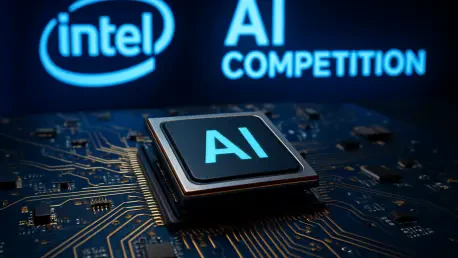What happens when a titan of technology, once synonymous with cutting-edge computing, starts to falter in the race for dominance? Intel, a name etched in the history of semiconductors, now faces a pivotal moment as competitors like NVIDIA and AMD accelerate ahead in artificial intelligence and chip innovation. This unfolding drama isn’t just about one company’s struggles—it’s a glimpse into the relentless pace of tech evolution and the high stakes of staying relevant in a world driven by AI and advanced silicon.
Why Intel’s Struggles Resonate Beyond Silicon Valley
Intel’s challenges carry weight far beyond boardrooms and stock tickers. The company’s chips power everything from personal laptops to the massive cloud servers that underpin digital infrastructure, meaning any stumble could disrupt global supply chains or inflate device prices. With AI reshaping industries like healthcare and finance, Intel’s ability to keep pace directly impacts how quickly transformative technologies reach the masses, making its current trajectory a concern for consumers and policymakers alike.
Moreover, Intel’s position reflects broader geopolitical tensions. As nations vie for technological supremacy, a weakened Intel could affect national strategies for innovation and economic security. With rivals gaining ground, the stakes are high—Intel’s story is a lens through which to view the fierce competition driving the future of tech.
Intel’s Crossroads: Can a Giant Pivot Fast Enough?
Scrutiny surrounds Intel as it navigates a trio of pressing issues threatening its legacy. The decision to spin off its Network and Edge Group (NEX), a unit specializing in networking silicon for telecom, signals a strategic retreat to core strengths. Industry analyst Jack Gold from J. Gold Associates notes that while NEX holds value in a niche market, it’s not central to Intel’s broader vision, raising questions about whether such divestitures sharpen focus or sap momentum.
Financial pressures compound the challenge, particularly around the costly 14A node process—a critical step for next-generation chips. During a recent earnings call, CEO Lip-Bu Tan’s remarks about needing strong customer commitments sparked confusion, with some fearing cancellation. Expert Jim McGregor from Tirias Research clarified that Intel remains committed, but the incident underscores a delicate balance between innovation and fiscal restraint in an industry where investments often run into billions.
Perhaps most telling is Intel’s diminished presence in AI. Excluded from a high-profile White House event where NVIDIA and AMD were celebrated, Intel’s absence highlights a glaring gap in cloud-based AI solutions. Despite some foothold in PC-based AI with products like Gaudi, the company struggles to match competitors shaping the field’s future, casting doubt on its ability to reclaim lost ground.
Expert Perspectives: What Industry Insiders See
Voices from the tech sector paint a nuanced picture of Intel’s predicament. Analyst Jack Gold predicts that the NEX spinoff won’t result in a full sale to a giant like Cisco, but rather a model where Intel retains a stake, mirroring past divestitures like Mobileye. This approach, he suggests, allows Intel to offload operational burdens while maintaining influence in a specialized market.
On the financial front, Jim McGregor emphasizes that Tan’s earnings call comments reflect pragmatism, not retreat. The push for customer commitments before massive 14A investments is a standard industry tactic to mitigate risk, though the market’s initial misinterpretation reveals how closely Intel’s words are parsed. Such scrutiny amplifies the pressure to communicate with precision, especially when billions in capital are at stake.
Regarding AI, experts express concern over Intel’s fading relevance. While not entirely out of the race, the company’s impact in cloud AI—the dominant growth area—remains minimal compared to NVIDIA’s stronghold. This consensus points to a critical need for Intel to redefine its approach, as competitors continue to set the agenda in a field pivotal to tech’s evolution.
Charting a Path Forward: Strategies for Recovery
For Intel to regain its footing, deliberate action is essential. Post-NEX spinoff, redirecting resources toward core processor technology and manufacturing leadership stands as a priority. This means intensifying R&D for nodes like 14A, ensuring they not only launch but dominate the market, positioning Intel as a frontrunner in performance and efficiency.
Clear communication must also take center stage. The earnings call fallout over 14A exposed vulnerabilities in how Intel conveys its plans. Regular, transparent updates on technological progress and customer partnerships could prevent future misunderstandings, stabilizing investor confidence and reinforcing trust among stakeholders.
Finally, reclaiming AI relevance demands bold innovation. Accelerating development of competitive cloud AI solutions, potentially through acquisitions or alliances, could bridge the gap with rivals. Highlighting unique strengths of products like Gaudi in niche segments might offer a starting point, while broader efforts build momentum to challenge the industry leaders.
Reflecting on Intel’s Journey and Next Moves
Looking back, Intel’s journey reveals a company wrestling with strategic shifts, financial caution, and competitive erosion. The NEX spinoff marked a calculated step to streamline focus, while the 14A node controversy highlighted the tightrope of balancing innovation with fiscal reality. The AI exclusion at a major event served as a stark reminder of ground lost to rivals.
Moving ahead, actionable steps emerge as vital for Intel’s resurgence. Prioritizing investment in cutting-edge chip processes, ensuring clarity in public messaging, and aggressively pursuing AI advancements through partnerships or innovation offer a roadmap. These efforts, if executed with precision, hold the potential to reposition Intel as a leader, proving that even a titan can adapt to the relentless demands of tech’s future.









